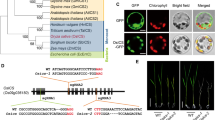Summary
Auxin (indole-3-acetic acid) is considered to be an important signalling molecule in the regulation of plant growth and development but neither auxin synthesis nor its mode of action is clearly understood. To identify genes involved in these processes, mutations were sought that altered the auxin requirement of plant tissues for growth. For the first time mutant plants were obtained that carry a recessive mutation at a single nuclear locus (auxl) which results in an absolute requirement for exogenous auxin for normal growth. In the absence of auxin treatment, mutant plants undergo premature senescence and die.
Similar content being viewed by others
Abbreviations
- BAP:
-
6-benzylaminopurine
- BUdR:
-
5-bromodeoxyuridine
- 2,4-D:
-
2,4-dichlorophenoxyacetic acid
- FUdR:
-
5-fluorodeoxyuridine
- IAA-EE:
-
indole-3-acetic acid ethyl ester
- IMS:
-
indole-3-methanesulfonic acid
References
Blonstein AD, Vahala T, Fracheboud Y, King PJ (1988a) Plant temperature-sensitive mutants isolated in vitro. Mol Gen Genet 211:252–259
Blonstein AD, Vahala T, Koornneef M, King PJ (1988b) Plants regenerated from auxin-auxotrophic variants are inviable. Mol Gen Genet 215:58–64
Cleland RE (1987) Auxin and cell elongation. In: Davies PJ (ed) Plant hormones and their role in plant growth and development. Martinus Nijhoff, Dordrecht, pp 132–148
Cohen J, Baldi B, Bialek K (1985) Strongly acidic auxin indole-3methanesulfonic acid. Plant Physiol 77:195–199
Hagen G (1987) The control of gene expression by auxin. In: Davies PJ (ed) Plant hormones and their role in plant growth and development. Martinus Nijhoff, Dordrecht, pp 149–163
Kao KN, Constable NF, Michayluk MR, Gamborg OL (1974) Plant protoplast fusion and growth of intergeneric hybrids. Planta 120:215–227
King PJ (1988) Plant hormone mutants. Trends Genet 4:157–162
Koornneef K (1986) Genetic aspects of abscisic acid. In: Blonstein AD, King PJ (eds) A genetic approach to plant biochemistry. Springer, Wien, pp 34–54
Letham DS, Goodwin PB, Higgins TJV (1978) (eds) Phytohormones and related compounds: a comprehensive treatise, vol II. Elsevier/North Holland, Amsterdam
Macdonald IR, Hart JW (1987) Tropisms as indicators of hormone-mediated growth phenomena. In: Hoad GV, Lenton JR, Jackson MB, Atkin RK (eds) Hormone action in plant development.Butterworths, London, pp 231–249
Reid JB (1986) Gibberellin mutants. In: Blonstein AD, King PJ (eds) A genetic approach to plant biochemistry. Springer, Wien, pp 1–34
Reinecke DM, Bandurski RS (1987) Auxin biosynthesis and metabolism. In: Davies PJ (ed) Plant hormones and their role in plant growth and development. Martinus Nijhoff, Dordrecht, pp 24–42
Suter M, Schnebli V, King PJ (1988) The development of a negative selection system for the isolation of plant temperature-sensitive auxin auxotrophs. Theor Appl Genet 75:869–874
Author information
Authors and Affiliations
Additional information
Communicated by H. Saedler
Rights and permissions
About this article
Cite this article
Fracheboud, Y., King, P.J. An auxin-auxotrophic mutant of Nicotiana plumbaginifolia . Molec. Gen. Genet. 227, 397–400 (1991). https://doi.org/10.1007/BF00273929
Received:
Issue Date:
DOI: https://doi.org/10.1007/BF00273929




